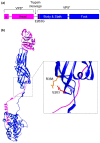VP4 Mutation Boosts Replication of Recombinant Human/Simian Rotavirus in Cell Culture
- PMID: 38675907
- PMCID: PMC11054354
- DOI: 10.3390/v16040565
VP4 Mutation Boosts Replication of Recombinant Human/Simian Rotavirus in Cell Culture
Abstract
Rotavirus A (RVA) is the leading cause of diarrhea requiring hospitalization in children and causes over 100,000 annual deaths in Sub-Saharan Africa. In order to generate next-generation vaccines against African RVA genotypes, a reverse genetics system based on a simian rotavirus strain was utilized here to exchange the antigenic capsid proteins VP4, VP7 and VP6 with those of African human rotavirus field strains. One VP4/VP7/VP6 (genotypes G9-P[6]-I2) triple-reassortant was successfully rescued, but it replicated poorly in the first cell culture passages. However, the viral titer was enhanced upon further passaging. Whole genome sequencing of the passaged virus revealed a single point mutation (A797G), resulting in an amino acid exchange (E263G) in VP4. After introducing this mutation into the VP4-encoding plasmid, a VP4 mono-reassortant as well as the VP4/VP7/VP6 triple-reassortant replicated to high titers already in the first cell culture passage. However, the introduction of the same mutation into the VP4 of other human RVA strains did not improve the rescue of those reassortants, indicating strain specificity. The results show that specific point mutations in VP4 can substantially improve the rescue and replication of recombinant RVA reassortants in cell culture, which may be useful for the development of novel vaccine strains.
Keywords: Sub-Saharan Africa; cell culture; next-generation sequencing; point mutation; replication kinetics; reverse genetics system; rotavirus; triple-reassortant.
Conflict of interest statement
The authors declare no conflicts of interest.
Figures





Similar articles
-
Generation of Simian Rotavirus Reassortants with VP4- and VP7-Encoding Genome Segments from Human Strains Circulating in Africa Using Reverse Genetics.Viruses. 2020 Feb 11;12(2):201. doi: 10.3390/v12020201. Viruses. 2020. PMID: 32054092 Free PMC article.
-
Strain-Specific Interactions between the Viral Capsid Proteins VP4, VP7 and VP6 Influence Rescue of Rotavirus Reassortants by Reverse Genetics.Int J Mol Sci. 2023 Mar 16;24(6):5670. doi: 10.3390/ijms24065670. Int J Mol Sci. 2023. PMID: 36982745 Free PMC article.
-
Establishment of a Reverse Genetics System for Rotavirus Vaccine Strain LLR and Developing Vaccine Candidates Carrying VP7 Gene Cloned From Human Strains Circulating in China.J Med Virol. 2024 Dec;96(12):e70065. doi: 10.1002/jmv.70065. J Med Virol. 2024. PMID: 39610277
-
Reverse Genetics Approach for Developing Rotavirus Vaccine Candidates Carrying VP4 and VP7 Genes Cloned from Clinical Isolates of Human Rotavirus.J Virol. 2020 Dec 22;95(2):e01374-20. doi: 10.1128/JVI.01374-20. Print 2020 Dec 22. J Virol. 2020. PMID: 33087468 Free PMC article.
-
Reverse vaccinology-based multi-epitope vaccine design against Indian group A rotavirus targeting VP7, VP4, and VP6 proteins.Microb Pathog. 2024 Aug;193:106775. doi: 10.1016/j.micpath.2024.106775. Epub 2024 Jul 1. Microb Pathog. 2024. PMID: 38960216 Review.
Cited by
-
Rotaviruses and Rotavirus Vaccines: Special Issue Editorial.Viruses. 2024 Oct 24;16(11):1665. doi: 10.3390/v16111665. Viruses. 2024. PMID: 39599780 Free PMC article.
-
Engineering human/simian rotavirus VP7 reassortants in the absence of UTR sequence information.Appl Microbiol Biotechnol. 2025 Feb 27;109(1):52. doi: 10.1007/s00253-025-13435-z. Appl Microbiol Biotechnol. 2025. PMID: 40014110 Free PMC article.
References
-
- Cohen A.L., Platts-Mills J.A., Nakamura T., Operario D.J., Antoni S., Mwenda J.M., Weldegebriel G., Rey-Benito G., de Oliveira L.H., Ortiz C., et al. Aetiology and incidence of diarrhoea requiring hospitalisation in children under 5 years of age in 28 low-income and middle-income countries: Findings from the Global Pediatric Diarrhea Surveillance network. BMJ Glob. Health. 2022;7:e009548. doi: 10.1136/bmjgh-2022-009548. - DOI - PMC - PubMed
-
- Troeger C., Khalil I.A., Rao P.C., Cao S., Blacker B.F., Ahmed T., Armah G., Bines J.E., Brewer T.G., Colombara D.V., et al. Rotavirus Vaccination and the Global Burden of Rotavirus Diarrhea Among Children Younger Than 5 Years. JAMA Pediatr. 2018;172:958–965. doi: 10.1001/jamapediatrics.2018.1960. - DOI - PMC - PubMed
Publication types
MeSH terms
Substances
Grants and funding
LinkOut - more resources
Full Text Sources
Research Materials

